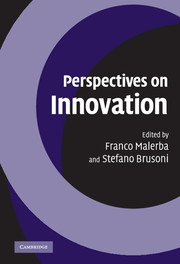Book contents
- Frontmatter
- Contents
- List of figures
- List of tables
- List of contributors
- Prefatory note
- Introduction
- Part 1 Innovation and economic growth
- Part 2 The microdynamics of the innovation process
- Part 3 Innovation and industrial dynamics
- Part 4 Innovation and institutions
- Part 5 Innovation, firms' organization, and business strategies
- Part 6 Innovation and entrepreneurship
- Part 7 Innovation and evolution of the university system
- Part 8 Innovations and public policy
- 15 Innovation systems, innovation policy and restless capitalism
- 16 Intellectual property rights and competition policy
- 17 The policy-shaper's anxiety at the innovation kick: how far do innovation theories really help in the world of policy?
- Index
16 - Intellectual property rights and competition policy
Published online by Cambridge University Press: 06 January 2010
- Frontmatter
- Contents
- List of figures
- List of tables
- List of contributors
- Prefatory note
- Introduction
- Part 1 Innovation and economic growth
- Part 2 The microdynamics of the innovation process
- Part 3 Innovation and industrial dynamics
- Part 4 Innovation and institutions
- Part 5 Innovation, firms' organization, and business strategies
- Part 6 Innovation and entrepreneurship
- Part 7 Innovation and evolution of the university system
- Part 8 Innovations and public policy
- 15 Innovation systems, innovation policy and restless capitalism
- 16 Intellectual property rights and competition policy
- 17 The policy-shaper's anxiety at the innovation kick: how far do innovation theories really help in the world of policy?
- Index
Summary
Introduction
Over the past decade or so, companies have begun to regard knowledge as a key source of competitive advantage, and they have learned to value – and protect – their knowledge-based assets. This, in turn, has led them to assert, and manage, their intellectual property rights more aggressively than hitherto. Since knowledge is typically protected by granting inventors or innovators a monopoly over the use of their protected intellectual property for a finite period of time, the aggressive exploitation of intellectual property rights looks a lot like the aggressive exploitation of any other monopoly position on the face of it, and this has begun to attract the attention of those concerned with designing or implementing competition policy.
At pretty much the same time, competition policy itself has risen up the policy agenda. In the United Kingdom, two major pieces of legislation have considerably strengthened the powers of competition authorities, increasing their independence, strengthening and deepening their powers, and increasing their resources. Much the same has occurred throughout Europe, particularly in those countries where competition policy has not, until now, taken deep root. And, on a global scale, competition policy has become more active and prominent as price-fixing cartels have been attacked in and between numerous countries.
The question that both of these developments raise is whether intellectual property rights and competition policy conflict with each other. In fact, a moment's reflection suggests that the relationship between competition policy and intellectual property rights is not straightforward. On the one hand, patents and copyrights give monopoly like powers that can, in principle, be abused This observation suggests that there may be serious conflicts between competition policy and intellectual property rights.
- Type
- Chapter
- Information
- Perspectives on Innovation , pp. 455 - 463Publisher: Cambridge University PressPrint publication year: 2007
- 1
- Cited by

